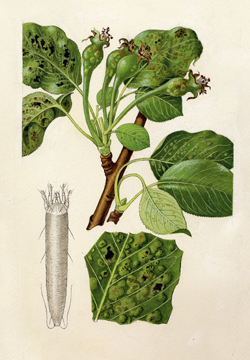Pearleaf blister mite
Eriophyes pyri
Biology
During spring shoots, gall mites migrate to the leaves (and fruits), where their sucking activity causes roundish-oval growths (poxes) on the leaf surfaces. In these poxes they lodge and lay their eggs. The next generation of gall mites also resides in these poxes and sucks in the plant tissue. When the leaves die, they leave the pox through a small opening and colonize new leaves. There are several generations annually. The gall mites of the last generation migrate to the buds and overwinter in groups between the bud scales.
Damage symptoms
In spring, pock-like formations can be seen on the upper and lower sides of the leaves, which are initially green and reddish, but soon turn blackish brown. Inside these pocks are the gall mites, which are not visible to the naked eye, but only with a magnifying glass or under a microscope.

Prevention and control
In case of low infestation, removal of infested leaves before the gall mites migrate is sufficient. This prevents overwintering and reduces the initial population for the next year.
If necessary, targeted control is possible only at the time of budbreak, when the gall mites have left their winter quarters, before the first pox appear. Net sulfur preparations and acaricides suitable for controlling free-living gall mites can be used (see list of plant protection products approved in Austria).
Last updated: 21.03.2025
automatically translated